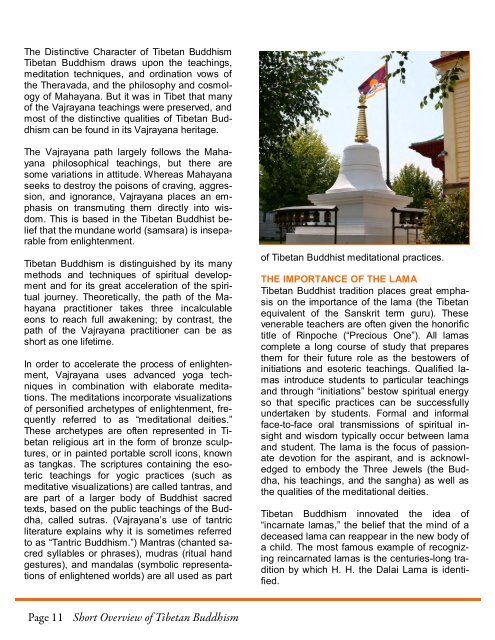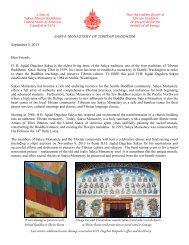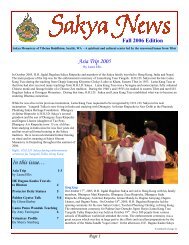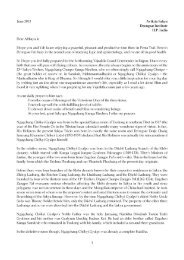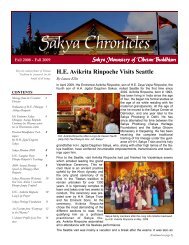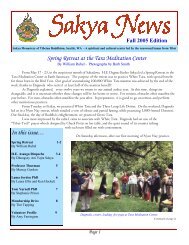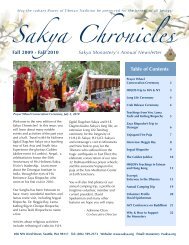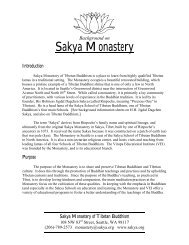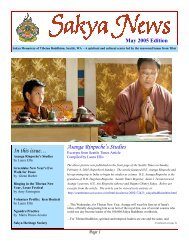Sakya Monastery of Tibetan Buddhism - the Sakya Monastery of ...
Sakya Monastery of Tibetan Buddhism - the Sakya Monastery of ...
Sakya Monastery of Tibetan Buddhism - the Sakya Monastery of ...
Create successful ePaper yourself
Turn your PDF publications into a flip-book with our unique Google optimized e-Paper software.
The Distinctive Character <strong>of</strong> <strong>Tibetan</strong> <strong>Buddhism</strong><strong>Tibetan</strong> <strong>Buddhism</strong> draws upon <strong>the</strong> teachings,meditation techniques, and ordination vows <strong>of</strong><strong>the</strong> Theravada, and <strong>the</strong> philosophy and cosmology<strong>of</strong> Mahayana. But it was in Tibet that many<strong>of</strong> <strong>the</strong> Vajrayana teachings were preserved, andmost <strong>of</strong> <strong>the</strong> distinctive qualities <strong>of</strong> <strong>Tibetan</strong> <strong>Buddhism</strong>can be found in its Vajrayana heritage.The Vajrayana path largely follows <strong>the</strong> Mahayanaphilosophical teachings, but <strong>the</strong>re aresome variations in attitude. Whereas Mahayanaseeks to destroy <strong>the</strong> poisons <strong>of</strong> craving, aggression,and ignorance, Vajrayana places an emphasison transmuting <strong>the</strong>m directly into wisdom.This is based in <strong>the</strong> <strong>Tibetan</strong> Buddhist beliefthat <strong>the</strong> mundane world (samsara) is inseparablefrom enlightenment.<strong>Tibetan</strong> <strong>Buddhism</strong> is distinguished by its manymethods and techniques <strong>of</strong> spiritual developmentand for its great acceleration <strong>of</strong> <strong>the</strong> spiritualjourney. Theoretically, <strong>the</strong> path <strong>of</strong> <strong>the</strong> Mahayanapractitioner takes three incalculableeons to reach full awakening; by contrast, <strong>the</strong>path <strong>of</strong> <strong>the</strong> Vajrayana practitioner can be asshort as one lifetime.In order to accelerate <strong>the</strong> process <strong>of</strong> enlightenment,Vajrayana uses advanced yoga techniquesin combination with elaborate meditations.The meditations incorporate visualizations<strong>of</strong> personified archetypes <strong>of</strong> enlightenment, frequentlyreferred to as “meditational deities.”These archetypes are <strong>of</strong>ten represented in <strong>Tibetan</strong>religious art in <strong>the</strong> form <strong>of</strong> bronze sculptures,or in painted portable scroll icons, knownas tangkas. The scriptures containing <strong>the</strong> esotericteachings for yogic practices (such asmeditative visualizations) are called tantras, andare part <strong>of</strong> a larger body <strong>of</strong> Buddhist sacredtexts, based on <strong>the</strong> public teachings <strong>of</strong> <strong>the</strong> Buddha,called sutras. (Vajrayana’s use <strong>of</strong> tantricliterature explains why it is sometimes referredto as “Tantric <strong>Buddhism</strong>.”) Mantras (chanted sacredsyllables or phrases), mudras (ritual handgestures), and mandalas (symbolic representations<strong>of</strong> enlightened worlds) are all used as part<strong>of</strong> <strong>Tibetan</strong> Buddhist meditational practices.THE IMPORTANCE OF THE LAMA<strong>Tibetan</strong> Buddhist tradition places great emphasison <strong>the</strong> importance <strong>of</strong> <strong>the</strong> lama (<strong>the</strong> <strong>Tibetan</strong>equivalent <strong>of</strong> <strong>the</strong> Sanskrit term guru). Thesevenerable teachers are <strong>of</strong>ten given <strong>the</strong> honorifictitle <strong>of</strong> Rinpoche (“Precious One”). All lamascomplete a long course <strong>of</strong> study that prepares<strong>the</strong>m for <strong>the</strong>ir future role as <strong>the</strong> bestowers <strong>of</strong>initiations and esoteric teachings. Qualified lamasintroduce students to particular teachingsand through “initiations” bestow spiritual energyso that specific practices can be successfullyundertaken by students. Formal and informalface-to-face oral transmissions <strong>of</strong> spiritual insightand wisdom typically occur between lamaand student. The lama is <strong>the</strong> focus <strong>of</strong> passionatedevotion for <strong>the</strong> aspirant, and is acknowledgedto embody <strong>the</strong> Three Jewels (<strong>the</strong> Buddha,his teachings, and <strong>the</strong> sangha) as well as<strong>the</strong> qualities <strong>of</strong> <strong>the</strong> meditational deities.<strong>Tibetan</strong> <strong>Buddhism</strong> innovated <strong>the</strong> idea <strong>of</strong>“incarnate lamas,” <strong>the</strong> belief that <strong>the</strong> mind <strong>of</strong> adeceased lama can reappear in <strong>the</strong> new body <strong>of</strong>a child. The most famous example <strong>of</strong> recognizingreincarnated lamas is <strong>the</strong> centuries-long traditionby which H. H. <strong>the</strong> Dalai Lama is identified.Page 11Short Overview <strong>of</strong> <strong>Tibetan</strong> <strong>Buddhism</strong>3


